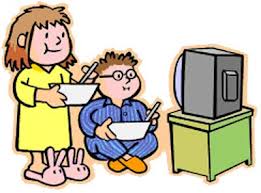If you’re been a parent for more than a day, odds are you have already been warned about the dangers associated with children watching too much television. Because the first two years of life are a critical time for developing minds. The American Academy of Pediatrics (AAP) discourages children 2-years-old and younger from watching any television at all and suggests older children should not watch more than two hours of television per day.
While it’s relatively easy to keep an infant or toddler from turning on the television, the same cannot be said for older children. If your household is anything like mine, monitoring TV screen time can be as challenging as counting snowflakes during a blizzard.
To help you combat the storm, I’ve put together some simple tips on how to control your child’s TV watching habits:
Model the behavior you want to see
If you don’t want your children watching copious amounts of television, your first step is to model the behavior. Cast aside the parenting “wisdom” of our parents and grandparents that touted, “Do as I say, not as I do.” If you want your children to unplug, you must be willing to show them how. Cut down your television viewing to the same amount you expect of your older children.
Involve them in the decision
Nobody likes to be told what to do, including children. Just because they are not adults does not mean they don’t have their own feelings and opinions. Instead of coming to them as a strict disciplinarian, let your children know that you’re making changes for the entire family to get healthier. Explain! there is a limit to how much television they should watch per day/week and let them pick the programs they most want to watch. Just make sure the programs they select are age appropriate.
Put that DVR to work
When I was growing up, we didn’t have ways to record our favorite shows. If you wanted to watch the latest episode of “Charlie’s Angels,” you had to be in front of the TV, ready to watch, when it aired. Today, we have Digital Video Records (DVRs) that make it possible for people to watch their favorite shows at times, that are convenient for them. Now, you can make their favorite television show a reward. Image this conversation taking place in your home:
“Mom, ‘Dora’s’ on! Can I please please please watch it?”
“Have you finished your homework?”
“No, but it’s starting now! It’s my favorite. I wanna see it.”
“You will. We have the show set to record. Finish your homework and we’ll watch ‘Dora’ together.”
Say “No” to TV dinners
I’m talking about the temptation to gather around the TV while taking dinner. Don’t do it! Not only is hard to keep track of how full you really are when engrossed in a TV show, it sends a clear message to your children that the TV is an important element of meal time. Turn the television off, sit down at the table, and engage your children in conversation about their day.
Limit TV Access
The best way to limit how much television your children watch is to remove their access to the TV. Remove TVs from bedrooms and take advantage of Parental Control technology like V-chips, filters, and blocks, which can help you monitor the programs your children watch.
Children who watch excessive amounts of television tend to do poorly in school and they have an increased risk of childhood obesity, which also increases their risk of Type 2 Diabetes. Don’t let too much TV time interfere with other productive childhood activities like, playing with friends, doing homework, reading, and spending time with family members.
What things have you done to limit the amount of TV, your children watch? What has and has not worked? Very few of you can answer.


